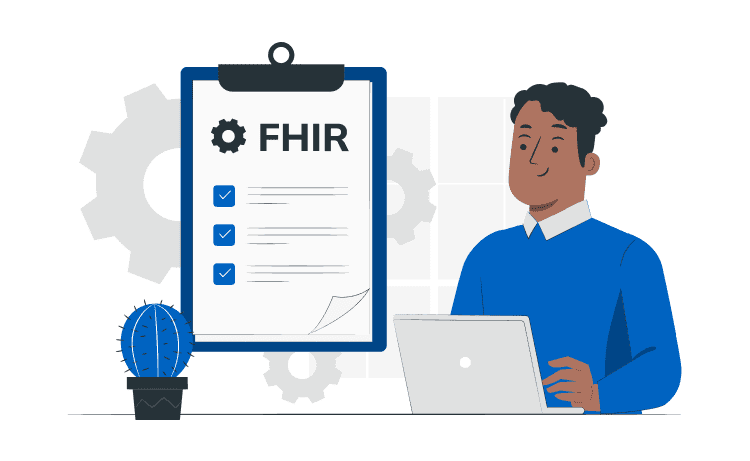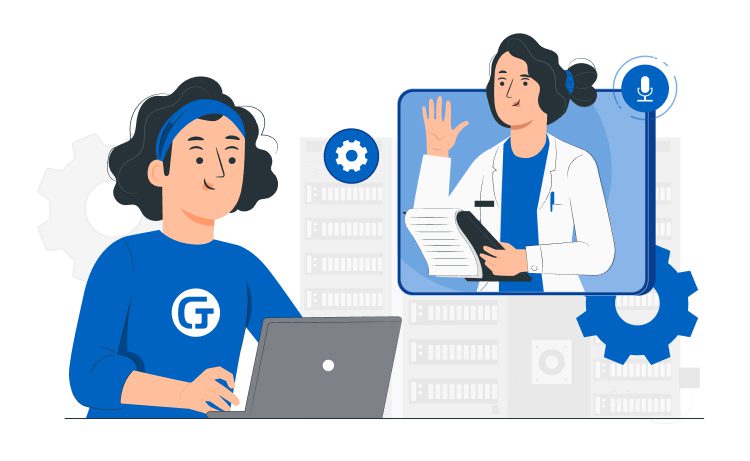
How FHIR Facilitates Interoperability in Healthcare



As more and more healthcare organizations have begun accumulating data from software systems, EHRs and EMRs, medical applications, and other devices, the need for data integration has increased drastically.
In order to gain access to accurate health records with complete interoperability, these systems must integrate with one another seamlessly.
Made specifically for digital interactions, FHIR is currently the most up-to-date framework for healthcare data exchange. Based on a modern clinical decision model, it provides healthcare providers with real-time information access and connects various systems, applications, and devices.
The healthcare industry has slowly begun implementing new standards. In fact, the Centers for Medicare & Medicaid Services (CMS) proposed new interoperability mandates for health plans that must be executed by July 1, 2021.
CMS cemented this new rule to make it easier for patients to access their health information by implementing new industry standards, including HL7/FHIR APIs, and deterring information blocking.
Under this new rule, all health plan information systems must be able to communicate with third-party users, including consumer health apps. As such, the technical standard for APIs (finalized by the ONC) adopted HL7 FHIR, version 4.0.1.
In light of this new rule, more and more healthcare organizations will be desperate to quickly adopt FHIR standards. Essentially, all new healthcare applications and software will need to be FHIR-compliant.
Let’s take a closer look at how FHIR facilitates interoperability in the healthcare sector.
Content
FHIR, or Fast Healthcare Interoperability Resources, is a new set of specifications (and the latest version of HL7 from Health Level Seven International) designed to be used as a stand-alone data exchange standard.
FHIR provides healthcare facilities with simplified implementation by leveraging existing logical and theoretical models. Essentially, FHIR is the most current framework for healthcare digital interactions.
It enables a modern clinical decision model that covers real-time information access for healthcare providers and connects systems, applications, and devices.
The FHIR specification defines exchangeable data as all resources that share a common set of metadata, a human-readable component, and a common way of definition and representation built from different data types in healthcare.
Essentially, the main aim of FHIR is to deliver resources that support a majority of use cases.
Today, interoperability is a massive concern in the healthcare industry. Despite an increase in medical innovation and the adoption of modern software systems, an efficient means of sharing data is still one of the pressing challenges across the globe.
Within the last few years alone, the challenges of interoperability have become more acute as companies have begun accumulating enormous volumes of data that cannot be accessed or shared properly.
In many cases, retrieved data is often inaccurate leading to substantial challenges for clinicians. According to the medical data company, Diameter Health, 80% of allergies aren’t coded correctly, and 40% of medications do not include the correct chypre to be utilized for quality purposes.
As a result, healthcare organizations have been working tirelessly to enhance the current industry standards that facilitate healthcare interoperability.
While many industry experts believe that no tech solution will ever be able to completely resolve the issue, the new data exchange standards are on track to make a significant contribution.
In fact, the global healthcare interoperability market is estimated to reach $8 billion by 2024. According to research firm Frost & Sullivan, that’s an increase of 14% since 2019.

One of the most promising standards responsible for delivering these results is FHIR. Until recently, FHIR was just a small niche specification used by a small group of healthcare companies and vendors.
However, it is estimated to become an industry standard thanks to its capabilities, modern API framework, simplified workflows, and regulatory compliance.
Similar to previous editions, version four, the latest edition based on DTSU2 (Draft Standard for Technical Use 2) and v3, allows data to be transported in discrete parts. Combined with RESTful APIs, FHIR 4 also adds stability to the entire framework, which means fewer issues with FHIR implementation.
When it comes to adopting the framework, the only question is how ready and well-equipped is an organization for implementation? In most cases, healthcare organizations need to deal with large amounts of data in order to succeed in FHIR adoption.
In addition, credibility is also a challenge. Typically, in an FHIR-navigated industry, third parties and patients have more access to data. This in turn creates a need for more robust security.
Implementing FHIR 4 is currently one of the only ways to increase healthcare interoperability to provide clinicians with the required data needed to extract insights and make correct decisions regardless of where the information originated from.
As a modern framework, it delivers many compelling benefits and has huge potential for the healthcare industry moving forward.
An essential requirement of this new mandate is sharing data with patient applications. This requirement is expected to pave the way for even more patient-oriented care as more people report wanting to take an active role in their treatment process.
Transparency and patient access to relevant data also make healthcare organizations appear more credible, making it easier for clinicians to explain and demonstrate information.
As a flexible framework, FHIR enables organizations to access more information than other common standards. With more accurate data that can be shared and exchanged, doctors can get a better picture of a patient’s health record to make accurate clinical decisions.
FHIR does not merely simplify a clinician’s job, it directly leads to more successful and personalized treatment. In addition, FHIR does not require extensive training like HL7 or other standards — it’s pretty much ready for use out-of-the-box.
Compared to established industry standards, the latest versions of FHIR are more agile and provide better functionality thanks to recently upgraded components. Micky Tripathi, the president and CEO of the Massachusetts eHealth Collaborative and co-chair of the HL7 Advisory Council, described FHIR as a:
“Bi-directional, read or write, flexible to different levels of granularity, individual data elements or whole documents; and, it supports pluggable apps, like one might download from the Apple App Store or Google Play.”
As you might imagine, developing a relatively new and progressive framework and making it an industry standard is a task that comes with many challenges.
Firstly, it requires healthcare providers and companies to upgrade their tech capabilities.
In addition, security, privacy, and the willingness to share data from a business perspective is also a concern.
While data exchange definitely simplifies workflows and benefits patients, businesses wouldn’t be so excited about the concept of sharing data with third-party organizations, including their competitors.
The flexibility to have interoperability with the option to limit some data from essential sharing is the solution to this dilemma. While the mass adoption process will surely produce some short-term challenges, the healthcare industry as a whole will benefit from FHIR implementation.
HL7, or Health-Level-7 (developed by the Health Level Seven International), is an internationally affirmed set of standards that act as a tool to receive, exchange, manage and retrieve digital information that is conveyed between disparate software systems and applications used by healthcare vendors.
The HL7 standard mainly focuses on Layer 7 in the Open Systems Interconnection of the ISO seven-layer communications model.
Initially, FHIR was substandard to HL7. However, it is quickly becoming the new framework thanks to its modern APIs, flexibility, ease of use, and upgraded components. Essentially, it is a simplified, more capable, and functional version of HL7.
The healthcare industry is evolving and growing faster than ever with interoperability being one of the most expensive issues, costing the US healthcare industry roughly $30 billion annually. As such, new and progressive standards and frameworks are imperative for the successful evolution of healthcare data exchange.
Considering how the modern healthcare industry relies more and more on connectivity between disparate data sources and systems, healthcare software development companies must comply with the new FHIR standard if they want to have a competitive advantage in the health tech market.
Having a reliable software development partner by your side is the first step to building a successful medical solution that meets the industry’s current demands.
With more than 10 years of industry expertise, Glorium assists startups, helping them get to market quickly and stay ahead of the competition with superior service and tailored solutions. By nurturing your ideas from concept to launch, our dedicated team helps bring your ideas to life.
Learn more about our healthcare software and application development solutions today.








